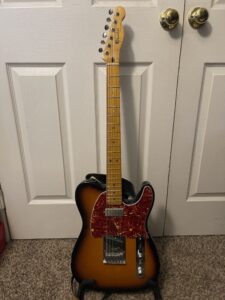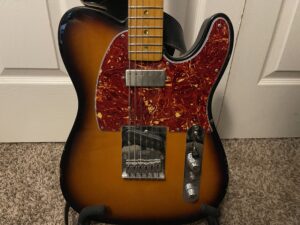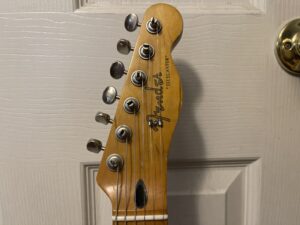 Over the years, I’ve owned a number of guitars that either didn’t cost me very much or that many would agree were “cheap”.
Over the years, I’ve owned a number of guitars that either didn’t cost me very much or that many would agree were “cheap”.
My first handful of electric guitars were a 3/4 size Memphis Strat-style, an MIJ Squier Contemporary Series Stratocaster, a Lyon (Washburn’s “cheap” brand) Strat copy, and a $99 Epiphone Les Paul Special II. Heck, my friends’ first electrics were a MIK Squier II Stratocaster and a Cort Effector version of an Explorer.
With that MIJ Squier Strat being the outlier, and as much as I think my friends and I all liked playing that MIK Squier II, I was unknowingly experienced with cheap guitars in the first few years I played guitar.
I, unjustly, hated that guitar and everything about it…the headstock, the “not quite Les Paul” single cutaway, the silver neck pickup, the control plate…I hated that Tele and therefore I hated all Teles. They weren’t a Strat and therefore they were inferior.
For years, that Tele shaped my opinion of all things Tele until I had the opportunity to buy one SUPER cheap. My opinion would forever change and that guitar would become the guitar that has stuck around longest out of any guitar I’ve ever owned.
I never said my opinions were sound, good, or resembled anything close to either of those.
Pawn Shopping
This story is one where you point to your kids and say “Kids, this is how NOT to do things. This is how to be dishonest and swindle a pawn shop”.
In my defense, don’t most pawn shops take advantage of and swindle people who are desperate and in need of money? I mean, I’m no “Robin Hood of the Pawn Shops” here, but I was just taking something back for the little man, Right?
I used to stop at random pawn shops to see what they had. My wife and I called it “pawn shopping”. There was a chain that used to have a very particular pricing system that effectively displayed how much money the shop had invested in an item right on the tag.
If you didn’t know the system, you just thought it meant nothing, but someone had shared the code with me and I used it to score the occasional killer deal, like an Audio Technica AT4040 for $50 that I sold for $400.
Just a Look
My wife and I had been over in Dallas to check out a bougie grocery store that I’d seen when I worked out that way. The pawn shop in question was just off the highway and I spied the sign on my way there and pulled in on the way back.
“I’m just going in to look,” I told her, stressing the word look. I was not being dishonest…I had no intention of buying anything. We walked inside and on the wall hung a Tele that had seen better days. It was a three color sunburst with a black pickguard. Very average-at-best looking.
Remember, I was not at all fond of Telecasters, had not given one a single thought, and this one was no different. However, it was the only decent guitar on the wall.
I picked it up and noticed the bridge was odd. I used my phone to Google what it was and learned it was a Fishman VT Powerbridge, which contained a piezo pickup generally used in acoustic instruments. While I had a high level understanding of what it did, it wasn’t of much interest to me.
The guitar had different pickups than most Teles did: a Rio Grande Muy Grande and Halfbreed. I had no idea what that brand meant, but it didn’t have the silver cover on the neck pickup, so that was a win.
I looked at the tag and the pricing scheme told me the pawnshop had $50 invested. They were asking $300, which wasn’t shabby for a Made in Mexico Fender, but I didn’t want to pay $300 for a guitar that I was trying more out of obligation than interest.
The sales rep came over and I asked for a cable to try it out. While I waited, I strummed a few chords. The neck was quite comfortable and was one of the nicer necks I’d played at that point in time. Cracks quickly appeared in the walls that kept my heart separated from Teles everywhere.
When the rep arrived with the cable, I plugged the guitar up, turned up the amp a little, and strummed a chord expecting the worst.
Bzzzt-grrrch
It was worse than the worst I’d expected. The guitar didn’t even work. It made this fizzy electronic sound. I’d only owned one, but I recognized that terrible sound as the sound that active pickups make when the battery they need to power them is dead. I turned the guitar over for the first time and saw a battery compartment.
“Of course the Fishman is active,” I thought to myself. I’d known this after reading briefly about what the bridge was but didn’t even think about it. I took the battery out and put it to my tongue. It was dead as a door nail.
Yeah, let’s not even start to discuss just how nasty that was of me to do that. It’s been over 15 years later and I’m still put off by that.
A Lie By Omission
I pulled my wallet out and saw $85 in cash from a pedal I’d sold a few days before. Breaking down their code, I realized the store had $50 bucks invested. I hoped they’d take a 70% profit on what appeared to be a dead guitar.
I called the sales rep over, explained that the guitar wasn’t working right, plugged it in, and showed them the “bzzzt-grrrch” noise. He made a face. That particular sound isn’t all that pleasant.
The rep went over and asked the manager to come over. I showed them the same noise, and he immediately agreed to $85 out the door. For the price of $78.53 plus 8.25% tax, I walked out of the pawnshop with a beat up Tele.
Should I have told them about the battery thing? The correct answer, at least in a world of binary morality, is yes. It would have been transparently honest. In D&D terms, it would have been the “Lawful” thing to do.
That being said, I didn’t lie. I DID say it wasn’t working right, I just omitted how easy of a fix it would be. As the seller, one may justify the behavior by saying it was their responsibility to know about the product their selling, and given how little money they had in the guitar, I have a feeling they had no issue offering as little as they could for it.
It Worked Out
We got home, a fresh 9v battery went in, and it worked right away. In spite of the numerous chips, scratches, dents, and damage already done to it, the guitar played and sounded great. Normally, Telecasters are on the brighter side, but the Rio Grande pickups really tamed that.
I’d eventually pick up an SX Tele copy that had a tortoiseshell pickguard and I’d swap it out with the black one before selling the SX. That pickguard stayed on the guitar for quite some time and it now belongs to a friend of mine who bought another tele from me a couple of years ago.
Unfortunately, as things sometimes go, money became tight and I ended up selling for the guitar for $450…a tidy profit. A month later, I got a major bonus that would have kept it home. I really missed that guitar. But, life is full of quirky twists and turns.
As luck would have it, the same guitar come up on Craigslist within a month or two of that bonus coming in. I emailed the seller, and it was the same guy I’d sold it to. I immediately offered to buy it back for what he’d paid me for it, he accepted, and the guitar found its way back home…a home it’s had for the past 15+ years.
John Oliviera of Big John’s Guitars is a wizard, and has worked on pretty much every guitar I own or have owned for almost 15 years. While he’s out in Denton, TX, the drive is absolutely worth it. Over the years, he and I have had numerous conversations where time passes so swiftly that our time’s up before either of us realize it.
I think the very first work I ever had him do was swap the Rio Grande pickups out of this with the pickups in a ’96 American Telecaster I’d picked up after buying this. I thought if a MIM Fender Tele was good, a USA Tele would be even better. While it sounded better, at least to my ears, it did not play better.
I eventually sold that USA Tele to Guitar Center for my asking price…a rare feat. I saw they eventually sold it for $300 or so more than they gave me and it was gone pretty quick.
Shortly after quickly falling out of love with the USA stock pickups, I reached out to John and began inquired about a pretty significant bit of work. We went back and forth and discussed changing pretty much everything:
- adding a burled maple vaneer and arefinish in purple
- installing new pickups and wiring them however he wanted
- a refret with stainless steel frets
- staining the neck a vintage amber
- applying a spaghetti-style waterslide decal
- changing the dot inlays to abelone
- adding new tuners
- adding a burled maple vaneer and arefinish in purple
Pickups/Electronics
John suggested a set of GFS Power Rock pickups. They are stacked humbuckers that look like regular telecaster pickups (I’d softened on hating the silver neck pickup) but with increased, noiseless output. He wired them in the following setup on a 5-way switch:
- 5 – Neck in series
- 4 – Neck in parallel
- 3 – One coil from each pickup in parallel
- 2 – Bridge in parallel
- 1 – Bridge in series
Positions 2 and 4 offered this really mellowed out sound that really pulls back on whatever drive pedal I’m using. I used it for playing cleaner parts with just a hint of drive. If you mix in a little bit of the Piezo bridge, it adds a layer of sound that the magnetic pickups alone don’t give.
We replaced the volume knob that controlled the magnetic pickups with a concentric knob, which are two knobs in one, so I could have both a tone and volume control. The Piezo bridge knob retained its single knob, and we kept the mini-switch that controlled which pickups were active.

In 2021, and after 13 years, the neck pick up began to lose some of its oompf while the bridge pickup kept trucking along. I bought a Seymour Duncan Antiquity II Mini Humbucker, new pickguard, and John replaced it and wired things back up with the following options:
- 5 – Antiquity II in series
- 4 – Antiquity II and GFS (full)
- 3 – GFS parallel and Antiquity II
- 2 – GFS in parallel
- 1 – GFS in series
- While I don’t get that 2nd mellow option in the 4th position, I get this really interesting sound in the 3rd position. I haven’t quite fully explored it and how I can use it in recordings, but I really need to dig into it, especially if I dial in the piezo pickup.
The Neck and Tuners

If the neck was comfortable before, John took that comfort to a luxury level. He has a service where he contours the fretboard and I had him make that adjustment to my Tele. In the nearly 13 years since he worked that magic on the neck, it’s been back once for a very minor tweak.
I bought some Wilkinson vintage-style tuners off of the GFS site and installed them myself. I’ve always been fond of the way those looked and thought it classed the neck up a bit. The hardest part about the install was pre-drilling the new holes and not drilling through the headstock.
In April of 2022, I swapped out the Wilkinson tuners for a set of Fender Locking Tuners, which are hard to beat. Those locking tuners and make restringing a breeze.
With the serial number wiped away due to the neck refinish, I had a local shop at a nearby mall etched it on a new neck plate. It looks terrible. I want to have it redone so the engraving is more cut into the plate. I just need to find a place willing to do that.
Are the Neck and Body Actually USA Made?
I will probably be corrected and I welcome the correction, but after Googling around, in the early ’90s (I think until ’93) the Fender plant in Mexico didn’t have the machining hardware available to make their own necks and bodies yet.
Some make the claim that American made necks and bodies were shipped down and the guitars were then assembled with the normal hardware and electronics found in the Mexican-made Fender line at the time. That’s something that’s been debated, disputed, proven, and disproven on forums for years.
An interesting fact is that it’s quite likely that the wood is made of poplar with an alder vaneer. It doesn’t change my opinion of the guitar at all. It was interesting to read.
Whether it is or is not the case, the wood in this guitar has held up quite well in the 30+ years since it’s construction. The electronics, with the exception of that Fishman Piezo bridge, have been completely replaced, the wiring upgraded, and some definite wizardry done to the pickup options I have access to.
This Tele has been played on pretty much every song I’ve been a part of since 2017 and is the lead guitar on just about every KCWM track that I can think of. Given the wear and tear, it’s also the guitar I travel with.
I look back on my initial opinion of the Telecaster and realize just how wrong I was. I once thought that Stratocasters were the superior guitar. Over the years, I’ve owned too many Strats from every country they’re manufactured in, but I never found that felt as comfortable to play as any Tele I’ve owned.
It took one Tele, and a few years, for it to become my preferred body type. One, and it was even close to top of the line. Sure, the wizardry helps, but it was a great guitar when I picked it up off the hanger at that pawn shop so many years ago and continues to be one of my favorite guitars I’ve ever owned.
It just took taking it back for the little man to happen.
In a world of noise, be sound
– KC
